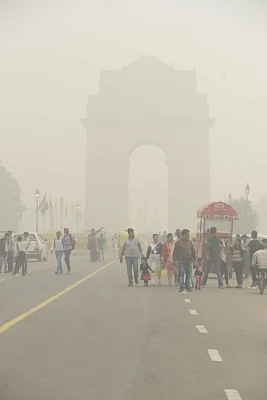New Delhi, Jan 17 (IANS) In addition to the well-known PM2.5 pollutant, alarming levels of "brain damaging" heavy metals such as manganese, nickel and lead have been found in Delhi and Gurugram air during November and December 2018, a report released by the Lung Care Foundation revealed on Thursday.
The report titled 'Death in every breath' analysed seven samples of air taken from Delhi and Gurgaon and in all the samples, PM2.5 were above statutory levels.
"PM2.5 levels ranged from 90.3 to 563.5 micrograms per unit and were between 1.5 and 9.4 times higher than standards prescribed by the Ministry of Environment, Forests and Climate Change (MoEFCC)," the report said.
Levels of manganese, it said, in five of the seven samples exceed the US EPA Reference Concentration for exposure to manganese (0.05 micrograms per unit) and the WHO annual health-based guidelines value of 0.15.
"There are no set standards in India for the manganese in the ambient air," the report said.
Dr Arvind Kumar of the Lung Care Foundation said heavy metals like manganese, lead and nickel are neurotoxins that damage the brain and children are more vulnerable to the effects of lead.
"Exposures to even low levels of lead early in life have been linked to effects on IQ, learning, memory and behaviour. It's a matter of very serious concern that such high levels of these toxic metals are found in the air that our children breathe," Kumar said.
"There is an urgent need for the policy makers to bring the focus back on the people and the health problems they are reporting to understand the impact of air pollution and its severity. People are the best monitors and they have been reporting severe health impacts already", added Dr. Kumar.
The lung care foundation has demanded that the Central Pollution Control Board (CPCB) initiates monitoring of heavy metals in dust and publish results periodically along with health advisories.
"Agencies should use the pollution data to apprehend polluters and take corrective action to bring levels of dust and heavy metals to below detection limits in residential areas," Kumar said.
The report also found high levels of barium in the national capital's air after Diwali.
"The barium level in the sample a day before Diwali was 21.5 micrograms per unit, on the day of Diwali the air sample has barium level of 5.8, and a day after Diwali, the barium level in the sample is 2.4," the report said.
Dr. Mark Chernaik, Staff Scientist at Environment Law Alliance Worlwide (ELAW), US, in a statement said: "These levels are extremely high and unheard of. Typically, barium levels are lower than 0.05 micrograms per unit. Based on limited human and animal data, the respiratory tract is the most sensitive target following inhalation of this metal."
According to a research, Barium, typically known as barium nitrate, imparts a yellow or "apple" green color to fireworks.
"Given that barium was found in samples around Diwali, it is quite likely that the fireworks caused this and barium along with other chemicals contributed to high levels of PM2.5 on those days", said Dr Chernaik.
Living with his family in Gurgaon, Sherebanu Frosh said it is high time that the governments and bureaucrats focused on ensuring cleaner air.
--IANS
sd/prs
(This story was auto-published from a syndicated feed. No part of the story has been edited by The Quint.)
